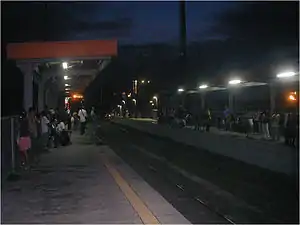Paco station
Paco is a station on the Southrail line of the Philippine National Railways. It serves Paco in Manila, Metro Manila. This is also the last station beside Quirino Avenue before turning left towards Pres. Sergio Osmeña Highway (formerly South Superhighway).
 Platform area of Paco station | ||||||||||||||||
| Location | Quirino Avenue cor. Pedro Gil Street Paco, Manila Philippines | |||||||||||||||
| Coordinates | 14°34′45″N 120°59′57″E | |||||||||||||||
| Owned by | Philippine National Railways | |||||||||||||||
| Line(s) | PNR Southrail Former: Cavite Line Naic Line | |||||||||||||||
| Platforms | Side platforms | |||||||||||||||
| Tracks | 2 | |||||||||||||||
| Construction | ||||||||||||||||
| Disabled access | Yes | |||||||||||||||
| Other information | ||||||||||||||||
| Station code | PC | |||||||||||||||
| History | ||||||||||||||||
| Opened | 1915 (original) 2009 (current) | |||||||||||||||
| Services | ||||||||||||||||
| ||||||||||||||||
| Location | ||||||||||||||||
 Paco Location within Metro Manila | ||||||||||||||||
PNR Metro Commuter | ||||||||||||||||||||||||||||||||||||||||||||||||||||||||||||||||||||||||||||||||||||||||||||||||||||||||||||||||||||||||||||||||||||||||||||||||||||||||||||||||||||||||||||||||||||||||||||||||||||||||||||||||||||||||||||||||||||||||||||||||||||||||||||||||||||||||||||||||||||||||||||||||||||||||||||||||||||||||||||||||||||||||||||||||||||||||||||||||||||||||||||||||||||||||||||||||||||||||||||||||||||||||||||||||||||||||||||||||||||||||||||||||||||||||||||||||||||||||||||||||||||||||||||||||||||||||||||||||||||||||||||||||||||||||||||||||||||||||||||||||||||||||||||||||||||||||||||||||||||||||||||
|---|---|---|---|---|---|---|---|---|---|---|---|---|---|---|---|---|---|---|---|---|---|---|---|---|---|---|---|---|---|---|---|---|---|---|---|---|---|---|---|---|---|---|---|---|---|---|---|---|---|---|---|---|---|---|---|---|---|---|---|---|---|---|---|---|---|---|---|---|---|---|---|---|---|---|---|---|---|---|---|---|---|---|---|---|---|---|---|---|---|---|---|---|---|---|---|---|---|---|---|---|---|---|---|---|---|---|---|---|---|---|---|---|---|---|---|---|---|---|---|---|---|---|---|---|---|---|---|---|---|---|---|---|---|---|---|---|---|---|---|---|---|---|---|---|---|---|---|---|---|---|---|---|---|---|---|---|---|---|---|---|---|---|---|---|---|---|---|---|---|---|---|---|---|---|---|---|---|---|---|---|---|---|---|---|---|---|---|---|---|---|---|---|---|---|---|---|---|---|---|---|---|---|---|---|---|---|---|---|---|---|---|---|---|---|---|---|---|---|---|---|---|---|---|---|---|---|---|---|---|---|---|---|---|---|---|---|---|---|---|---|---|---|---|---|---|---|---|---|---|---|---|---|---|---|---|---|---|---|---|---|---|---|---|---|---|---|---|---|---|---|---|---|---|---|---|---|---|---|---|---|---|---|---|---|---|---|---|---|---|---|---|---|---|---|---|---|---|---|---|---|---|---|---|---|---|---|---|---|---|---|---|---|---|---|---|---|---|---|---|---|---|---|---|---|---|---|---|---|---|---|---|---|---|---|---|---|---|---|---|---|---|---|---|---|---|---|---|---|---|---|---|---|---|---|---|---|---|---|---|---|---|---|---|---|---|---|---|---|---|---|---|---|---|---|---|---|---|---|---|---|---|---|---|---|---|---|---|---|---|---|---|---|---|---|---|---|---|---|---|---|---|---|---|---|---|---|---|---|---|---|---|---|---|---|---|---|---|---|---|---|---|---|---|---|---|---|---|---|---|---|---|---|---|---|---|---|---|---|---|---|---|---|---|---|---|---|---|---|---|---|---|---|---|---|---|---|---|---|---|---|---|---|---|---|---|---|---|---|---|---|---|---|---|---|---|---|---|---|---|---|---|---|---|---|---|---|---|---|---|---|---|---|---|---|---|---|---|---|---|---|---|---|---|---|---|---|---|---|---|---|---|---|---|---|---|---|---|---|---|---|---|---|---|---|---|---|---|---|---|---|---|---|---|---|---|---|---|---|---|---|---|---|---|---|---|---|---|---|---|---|---|---|---|---|---|---|---|---|---|---|---|---|---|---|---|---|---|---|---|---|---|---|---|---|---|---|---|---|---|---|---|---|---|---|---|---|---|---|---|---|---|---|---|---|---|---|---|---|---|---|---|---|---|---|
| ||||||||||||||||||||||||||||||||||||||||||||||||||||||||||||||||||||||||||||||||||||||||||||||||||||||||||||||||||||||||||||||||||||||||||||||||||||||||||||||||||||||||||||||||||||||||||||||||||||||||||||||||||||||||||||||||||||||||||||||||||||||||||||||||||||||||||||||||||||||||||||||||||||||||||||||||||||||||||||||||||||||||||||||||||||||||||||||||||||||||||||||||||||||||||||||||||||||||||||||||||||||||||||||||||||||||||||||||||||||||||||||||||||||||||||||||||||||||||||||||||||||||||||||||||||||||||||||||||||||||||||||||||||||||||||||||||||||||||||||||||||||||||||||||||||||||||||||||||||||||||||
It was originally built across Plaza Dilao in 1915, which was during the American colonial period. The old station, however, was partly demolished in 1996 by a developer that begun constructing a shopping mall next to it.[1] The demolition was not completed due to the cancellation of the mall construction, leaving the facade intact up to now. In 2009, the old station was replaced with a new station at the corner of Quirino Avenue and Pedro Gil Street.
In 2015, the Department of Transportation and Communications started plans to restore and conserve the old Paco railway station building. Heritage advocates including the Heritage Conservation Society welcomed the development.[2]
San Andres station in San Andres Bukid, Manila follows this station. Paco is preceded by Pandacan. There are also LRT Line 1 stations that exist not very far from the station, such as Pedro Gil and Quirino. It will require a commute from this station to get to those stations.
History

General Information
The Manila Belt Line from Santa Mesa to Paco and the segment of the defunct Cavite line to Binakayan were opened on March 25, 1908.
Construction of the station started in 1912 and was completed by 1915.[3]
Second World War
In the bid to reclaim Manila from the Japanese during World War II, Paco became a bloody battleground for hundreds of lives. On Feb. 7, 1945, the US 149th Infantry Regiment crossed Pasig River and landed in the suburbs of Pandacan and Paco with the Filipino troops under the Philippine Commonwealth Army, where a battle took place around the railway station with some 300 Japanese defending it; it was the “first of the urban strong points” the Allied forces encountered. According to an account, “Japanese [fighters] had machine gun posts all around the [railroad] station, and foxholes with riflemen surrounded each machine gun post. Inside at each corner were sandbag forts with 20mm guns. One large concrete pillbox in the building housed a 37mm gun.” Over a two-day period, the friendly forces won the encounter but it cost 335 American lives and 417 Filipino lives before the resistance was finally smashed and the enemies annihilated. The battle of Paco produced two Medal of Honor awardees, both members of the U.S. Company B, 148th Infantry, 37th Infantry Division which, along with the 149th Infantry Regiment, had the primary mission to attack Pandacan and Paco. The heroes of Paco were Technical Sergeant Cleto L. Rodriguez, of Mexican descent, and Private First Class John N. Reese, Jr., an American Indian.[4]
Station Layout
| L1 Platforms |
Side platform, doors will open on the right | |
| Platform A | PNR Metro Commuter towards Tutuban (←) | |
| Platform B | PNR Metro Commuter towards Alabang (→) | |
| Side platform, doors will open on the right | ||
| L1 | Concourse/ Street Level |
Ticket Booths, Station Control, Shops, Pedro Gil Street |
Nearby landmarks
The station is near Plaza Dilao, Paco Market, San Fernando de Dilao Church, Paco Catholic School, and Colegio de la Inmaculada Concepcion de la Concordia. Plaza Dilao is also where the statue dedicated to Blessed Dom Justo Takayama stands. The newest section of Skyway Stage 3 passes by the old and new stations.
See also
References
- My Activeworlds Constructions
- Palaña, Aberon Voltaire (June 23, 2015). "Paco restoration earns accolades". The Manila Times. Retrieved January 15, 2019.
- http://www.rihspi.org/about/agreements/2009-mou-with-pnr/